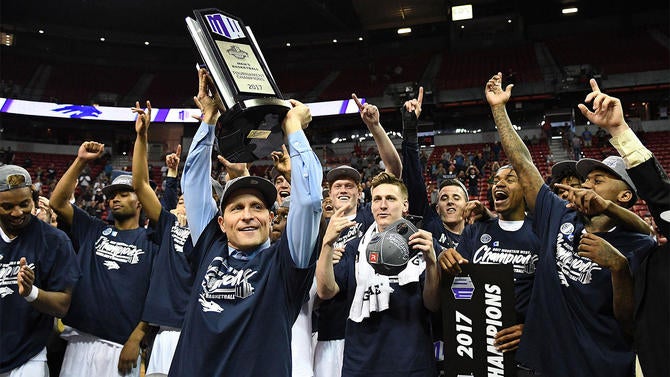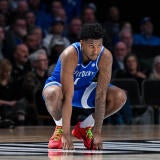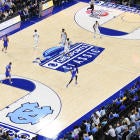It’s time for Americans to spend the next three days overanalyzing brackets or making picks based on team mascots. Either tactic may end up succeeding when it’s March Madness.
That said, matchups are the most important factor when filling out your bracket. Real basketball analysis actually matters. So does understanding your pool’s scoring system and how much victories are weighted. That might help determine how aggressive to be on your picks.
But just in case you really want to overanalyze and get no work done this week, here are 10 trends to consider.
1. National champs play offense and defense. Thirteen of the past 14 national champions finished in the top 20 of kenpom.com’s offensive and defensive efficiency ratings. The only school to buck that trend was 2014 Connecticut, which finished 39th in defensive efficiency. Four teams currently fit that criteria in 2017: Villanova, Gonzaga, Kentucky and Wichita State. It was nice of the NCAA committee to pair Wichita State (which got jobbed as a 10 seed) vs. Kentucky in a possible second-round game. (Note the sarcasm.)
Also note that since 2003, 80 percent of the Final Four teams were top 20 in defensive efficiency, which does not bode well for Duke, Kansas, Oregon, Florida State, Arizona, North Carolina, Butler or UCLA, none of which currently rank in the top 20 on defense.
That said, bear in mind that rules changes in 2015-16 shifted the game more in the offense’s favor. Villanova (No. 3 offensive efficiency) beat North Carolina (No. 1 offensive efficiency) in the 2016 championship game. The most efficient offenses this year are Oklahoma State, Villanova, UCLA, North Carolina, Michigan and Duke.
2. Final Four coaching experience matters. Coaches with previous Final Four experience have won 15 of the past 17 championships, and 24 of the past 29. This year, six coaches of top-three seeds haven’t been to the Final Four: Mark Few (Gonzaga), Scott Drew (Baylor), Sean Miller (Arizona), Steve Alford (UCLA), Leonard Hamilton (Florida State) and Dana Altman (Oregon).
Kevin Ollie managed to beat the trend in 2014 with Connecticut’s surprising national title. But it’s rare for a coach to cut down the nets in his first trip to the Final Four. Beware of picking any of those coaches above to win it all.
3. Avoid one-and-dones in conference tournaments. Since the field expanded to 64 in 1985, no team has ever won the NCAA title after losing its opening-round conference tournament game. This could be an ominous stat for No. 1 seed Kansas, which lost to TCU in the Jayhawks’ opening game of the Big 12 Tournament.
Other teams that went one-and-done in their conference tournament: Louisville, Baylor, Purdue, Florida and Butler. In the past nine years, 12 of the 24 top-four seeds that lost their first conference tournament game didn’t make the Sweet 16.

4. No. 1 seed often reigns supreme. It’s boring picking No. 1 seeds to win it all, and it didn’t happen last year when Villanova was the champ as a 2. But a 1 has won seven of the past 10 championships and 12 of the past 18. At least one No. 1 has made the Final Four every year except 1980, 2006 and 2011.
Villanova, Kansas, North Carolina and Gonzaga are the 1 seeds this season. However, the No. 1 overall seed (this year it’s Villanova) has won the title only three times in the past 13 years.
5. Don’t be afraid to advance unlikely seeds. Seven teams seeded 7 or lower have made the Final Four since 2011, including No. 10 seed Syracuse last year. Between 1981-2010, that happened only six times. Over the past six years, there have been more No. 7 or No. 8 Final Four teams than No. 3, 5 or 6 seeds.
Seventy-six percents of all NCAA Tournament upsets are by 10, 11 or 12 seeds (not counting 8-9 games), according to a Davidson University study. At least two double-digit seeds reached the Sweet 16 in 16 of the past 20 years, and at least one made it in 29 of the past 32 years. Look for talented double-digit seeds that underperformed in the regular season and/or have good matchups to make a run. Last year No. 11 Gonzaga got to the Sweet 16 by beating Seton Hall and Utah, and No. 10 Syracuse didn’t play a team seeded higher than No. 7 before the Elite Eight.
This year, Wichita State as a 10 certainly fits this criteria. Kentucky had better be careful if they indeed meet in the second round.
6. Ride a First Four team. A First Four team has reached the round of 32 in all six years of the format and been to the Sweet 16 in three of the past six years. There’s something to be said about getting a game under your belt before your first-round opponent plays a game.
Last year, Wichita State beat Vanderbilt in the First Four and then knocked off No. 6 Arizona. Most famously, VCU went from the First Four to the Final Four in 2011 as an 11 seed. Wake Forest, which had a late-season win over Louisville, could be a sneaky First Four team to win multiple games.
7. Pick at least 1 No. 12 seed to win. The 5 vs. 12 seed statistic feels as old as the 3-point line in college basketball. A 12 seed has defeated a 5 in 25 of the past 28 years. In the past five years, the 5 and 12 seeds have split their 20 games.
This year’s No. 12 threats: North Carolina-Wilmington (vs. Virginia), Nevada (vs. Iowa State), Princeton (vs. Notre Dame), and Middle Tennessee (vs. Minnesota). Don’t go crazy and take No. 12 seeds too far. No. 12 seeds have won only one of their past 20 Sweet 16 games.

8. If you’re bold, consider a No. 16 seed. The poor No. 16 seed is 0-128 all-time against No. 1s. Logically, it’s a huge gamble in your pool to pick a 16. The risk-reward is incredibly high. But there weren’t many conference tournament upsets this season, meaning there could be a better chance for a decent No. 16 seed to pull a shocker against a No. 1.
At least one No. 1 has lost in the round of 32 in five of the past seven years, so if there’s a No. 1 you really don’t like, maybe boot them vs. a 16. Is it likely? No. But talk to the Chicago Cubs, Cleveland Cavaliers, New England Patriots, Northwestern basketball, and Donald Trump about long odds over the past year. A No. 16 will eventually win. Why not now?
9. Stick with consistent conferences. The ACC has produced 14 Sweet 16 teams in the past four seasons, more than any conference. Duke and North Carolina are both elite. Notre Dame has been consistently strong. Louisville isn’t long removed from its 2013 national title. Virginia has become a quality program.
Other Sweet 16 appearances by conference since 2013: Big Ten 12, Pac-12 nine, Big 12 eight and SEC six. If the name isn’t Kentucky or Florida, you’re taking a risk by picking an SEC team to go far in March. The Big Ten hasn’t won the national title since 2000, and the Pac-12 goes back to 1997 (when it was the Pac-10) for its last national champ.
That said, be careful with the Pac-12 this year. UCLA and Arizona, particularly, are national title good.
10. Talent matters. Shocking, right? Thirty-five of the past 37 national champions had at least one McDonald’s high school All-American on their roster. Only 2002 Maryland and 2014 Connecticut didn’t have one. Top-four seeds Kansas, Duke, North Carolina, Kentucky, Gonzaga, UCLA, Louisville, Arizona, Florida State, Villanova, Purdue, Florida and Butler each have at least one McDonald’s All-American. Baylor, Oregon and West Virginia don’t have one.
Twenty-three of the past 28 national champions had two or more future NBA first-round picks, though that might not end up being the case for 2016 champion Villanova. In early NBA mock drafts for 2017, Duke, Kentucky, Arizona and UCLA are projected to have multiple first-round picks on their roster.
Bonus tip: Be willing to zig where other people zag. You win pools by getting the champion right — never underestimate how important that is — and choosing at least one different team in the Final Four or championship game than most people select.
If in doubt, ask someone who knows nothing about basketball.

















